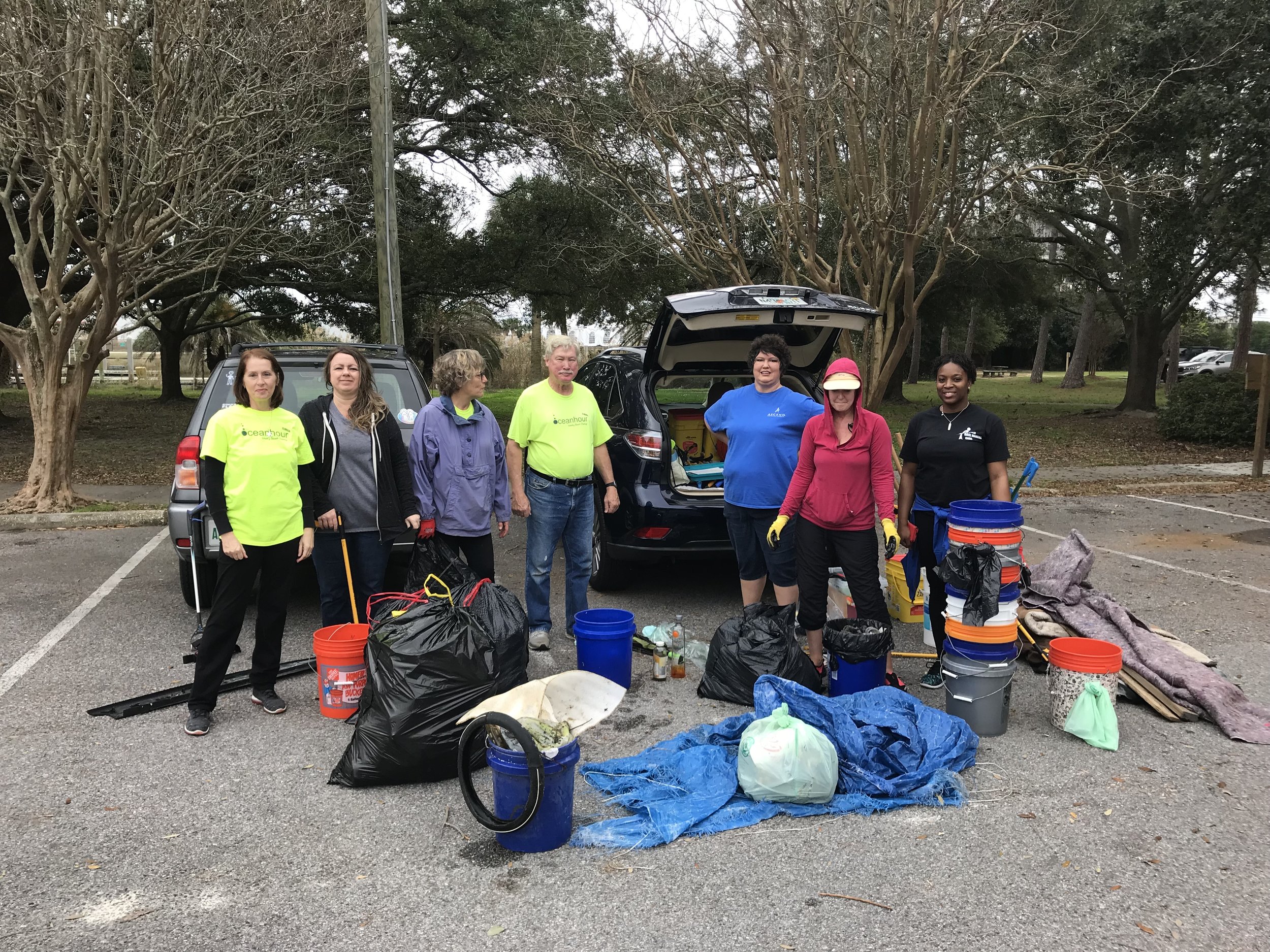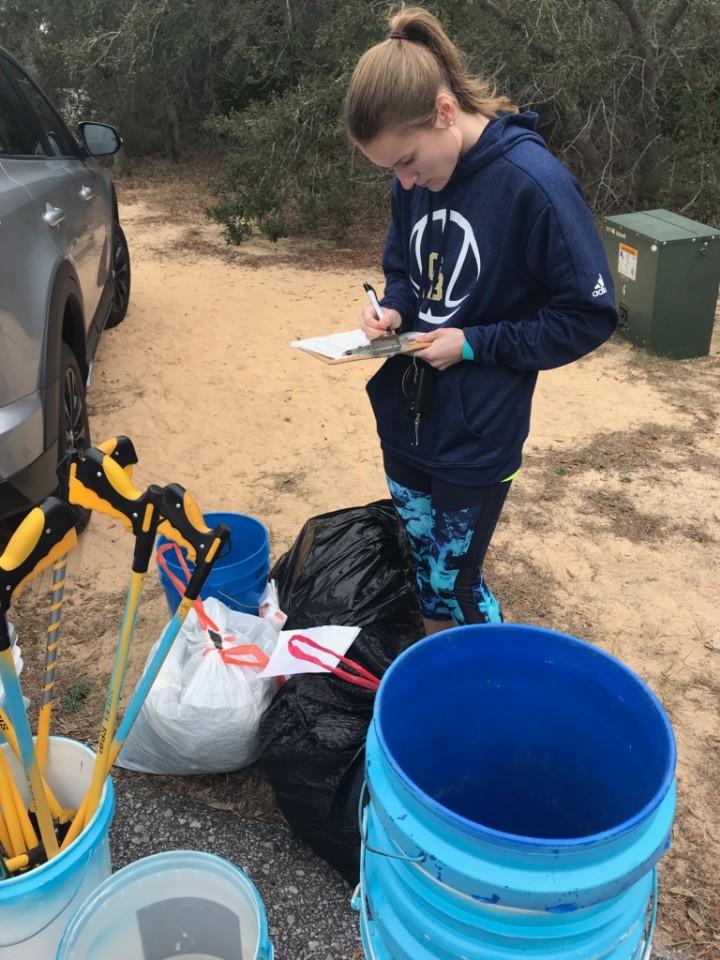52 volunteers at Ft. Pickens Fishing Pier, Langdon Beach and Lot 19A picked up 325 lbs of trash. Month’s total of 1,937 lbs! Well ahead of last year - thanks volunteers! Odd stuff - a wall thermostat, Cub Pack 410 made it out
Feb 16th Two sites cleaned up - Wayside and Bartram Parks
Today’s 66 volunteers are maintaining a weekly average trash pick up of 615 lbs in 2019. Groups contributing are Caldwell Bankers, Gulf Coast Citizen Diplomacy Council
Sharon Gincauskas makes Ocean Hour Volunteers proud!
Sharon Gincauskas is Gulf Breeze Rotary Club’s Citizen of the Year
https://news.gulfbreezenews.com/articles/gincauskas-is-gulf-breeze-rotary-clubs-citizen-of-the-year/
Feb 9th On a cool morning along Scenic Hwy...
Chimney Park 18 volunteers picked up 323 lbs of trash - a lot of adult beverage cans and water bottles. Meanwhile, at Bay Bluffs 305 lbs by 27 volunteers. Thanks to 2 people at NLO with 20 lbs
Feb 4th Another volunteer group joins in for a cleanup...
Thanks to the 19 volunteers from the NWFL Robot Spot Robotics team picking up 83 lbs at Graffiti Bridge
Feb 2nd 409 lbs Gathered at Four Sites
The locations were two at Naval Live Oaks, Bob Sikes Bridge and on Avalon Blvd. in Milton. Thanks to the 47 volunteers including GBHS Marine Science Club
From Jan 29th to Feb 4th at the Pensacola Airport...
The water bottle fill station near Gates 9 & 10 was used 1,947 times or > 1,947 water bottles weren’t discarded! Since so many bottles are found on our beaches, why aren’t there more stations in our area?
Jan 26 th Largest one day and month total!
At Quietwater Beach, 122 plastic straws vs 1 paper and 22 shotgun wads collected. 99 volunteers from Marine Ecology Research Society, GBHS Marine Science Club and Ocean Hour picked up 170 lbs. Meanwhile, at Bruce Beach 41 volunteers picked up 979 lbs! For the month on average each volunteer picked up 8 lbs of trash
Jan 19th Fortunately the predicted rain didn't happen!
UWF students and Caldwell Bankers were part of 22 volunteers at Bartram Park (223 lbs). A further 45 volunteers picked up 316 lbs at Wayside park - over 2,000 lbs so far this month
Senior Volunteers
http://www.aginginplace.org/how-to-volunteer-as-a-senior/
How To Volunteer As A Senior
Updated for January, 2019
Ramona Griego, an 81-year-old retiree, had recently lost her husband and, according to the AARP, her diabetes wasn’t getting any better. She soon developed depression and was looking for a way to improve her situation. After looking at different available options, Griego soon turned to volunteering.
With the help of the Corporation for National and Community Service, she got involved with her community after visiting a senior center and started helping people her own age stay active and engaged. She said, “The program has allowed me to enjoy my life as I age, and I feel important when I can help my clients with small things that allow them to remain in their homes.”
Volunteering truly gave Griego a new life. This is a common story for hundreds of thousands of elderly people. But this doesn’t mean that everyone knows how to get involved volunteering or the benefits of doing so. Before digging into that, let’s discuss how the breadth at which the elderly can volunteer.
Millions of elderly people—those 65 and older—volunteer every year, but given this population is higher than 48 million (and projected to reach 80 million by 2050), there is plenty of room for growth here.
Between 2011 and 2015, the rate of the elderly population that volunteered has stayed about the same, according to theBureau of Labor Statistics. (The rate has dropped about 5 percent for those between 55 and 64.) Although it’d be great to see an increase in that rate, that still means that more than 11 million seniors volunteered at least once in 2015. Overall, the elderly makes up almost 25 percent of the volunteer population, and if you include the 55-64 demographic, it’s more than 35 percent.
According to the Corporation for National Community & Service, the most common forms of volunteering are:
Collecting, serving, preparing, or distributing food
Fundraising or selling items to raise money
Engaging in general labor, like helping build homes or clean up parks
Tutoring or teaching
Mentoring the youth
Collecting, making, or distributing clothing
Because of the rate at which they are more likely to be retired, elderly people simply have more time on their hands than almost every other age demographic that’s eligible to work. Despite this, they don’t have the highest percentage of the population who volunteer—that belongs to those aged 35 to 54 who are also at the height of their working days. So let’s figure out exactly why volunteering is so important.Volunteering has its social, mental, and physical benefits for people of all ages. But these benefits truly reveal themselves for elderly folks, who often have more times on their hands, are less physically active, and engage less with the community than the average resident. According to research conducted by multiple outlets, volunteers live longer, and that’s because of a culmination of all the benefits we’re about to discuss.
Let’s take a look at some of the reasons:
Socially beneficial
One of the biggest difficulties for elderly people, especially after retirement, is staying social. Isolation occurs when seniors “have little contact with adult children, other relatives, or friends,” according to Forbes. The AARPestimates that up to 17 percent of Americans 55 and older could be isolated from society. Forbes also notes that the main issues that stem from being isolated include a higher rate or mortality, higher medical bills, and greater likelihood of developing an illness. Volunteering can pull elderly folks out of isolation, even if it’s only for a handful of hours a week. Volunteering at events at local religious institutions, parks, and museums are a great way to interact with a wide range people in the community.
Good for your mental cognition
As we age, there’s an increase in the likelihood of someone developing cognitive issues, other memory loss issues, and motor function diseases. One thing that can help slow the advancements of these diseases is staying active and using your brain. Volunteering provides opportunities to keep conversation flowing, constantly stimulate the brain, and help overall cognitive functions stay active. One study discovered that 70 percent of elderly people who were experiencing five or more symptoms of depression saw a decrease in those symptoms after their first year of volunteering.
Helps give back to the community
Just as it would feel good for any person, volunteering allows you to give back to the community. Something that may set an elderly person apart from any other individual is the wealth of knowledge they possess. Let’s say you spent 50 years feeding the poor while working for a nonprofit. You could then pass down generations of information to those looking to get into the nonprofit world at the volunteering level. This sense of giving isn’t limited to those who have worked a lifetime in a field, because elderly people can volunteer at youth camps, churches, and a slew of places where younger generations gather. You can even become a mentor to a young person simply by being around them, telling them stories, and teaching them about life.
Physically engaging
Whether it’s volunteering door-to-door for candidates in your local elections, helping build community gardens, or something in between, physical activity is vital for an elderly person. According to the University of Southern California’s School of Gerontology, less than one third of people between 65 and 74 are physically active. That number halves for those over 75. Inactivity as you age can promote the advancement of heart issues, bone loss, joint pain, fat, and a slew of other health issues. Getting out and volunteering can help combat these issues.









